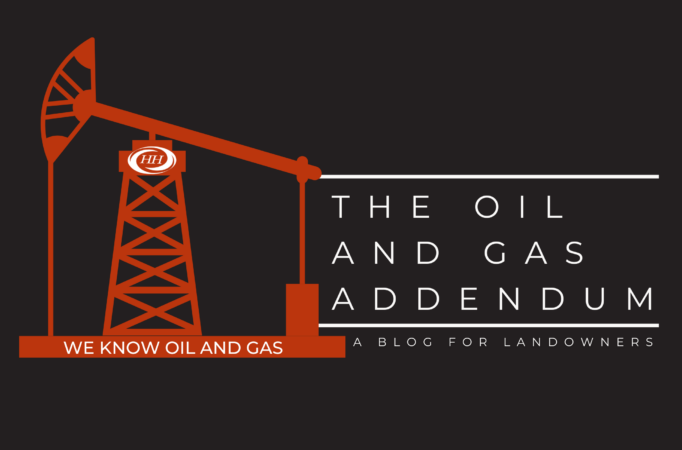The Oil and Gas Addendum
Ohio Federal Court Allows Subsurface Trespass Suit To Move Forward

This is a familiar yet troubling question. Imagine you own 135 acres in Washington County. You have received offers from several oil and gas drillers but have not yet signed a lease. Your neighbor, however, did sign a lease with XYZ Drilling back in 2019. XYZ Drilling constructed a well-pad on your neighbor’s parcel and subsequently drilled three (3) horizontal well bores into the Marcellus Shale Formation from that pad. Based on your review of the well records on file with the Pennsylvania Department of Environmental Protection (“Pa DEP”), it appears that a segment of one of the well bores passes within 100 feet of your property boundary. That well has been perforated and hydraulically fractured and is now producing significant volumes of gas every day. You are concerned that the well bore is now draining gas from underneath your property. Can XYZ Drilling remove and extract gas from the Marcellus Shale Formation under your unleased farm? A recent decision from the federal court in Ohio recognized that hydraulic fracturing operations can result in a subsurface trespass if the frac fissures extend into an unleased parcel. As detailed below, landowners and drillers here in Pennsylvania should closely follow and monitor the Golden Eagle Resources LLC v. Rice Drilling D LLC (Southern District of Ohio, 2.22 – CV – 02374, February 10, 2023) litigation as the law of subsurface trespass continues to evolve and develop.
At issue in Golden Eagle Resources LLC v. Rice Drilling D LLC were two oil or gas leases concerning 18.93 acres (the “Subject Parcels”) in Belmont County, Ohio (the “Subject Leases”). The Subject Leases explicitly excluded the hydrocarbon formations “below the base of the Utica Shale.” In other words, the Subject Leases allowed the lessee to produce hydrocarbons from the Marcellus Shale and Utica Shale Formations but prohibited production from any other deeper formations. In 2019, Rice Drilling D LLC (“Rice Drilling”) drilled a well known as the “Big Tex” well, which did not pass directly underneath the Subject Parcels. In 2020, Rice Drilling began producing hydrocarbons from the Big Tex well. The well bore, however, did not access or penetrate the Marcellus Shale Formation. Instead, according to the well completion reports, the Big Tex well bore penetrated the deeper Point Pleasant Formation, which lies below the Marcellus Shale and Utica Shale Formations.
In May 2022, the Plaintiff, Golden Eagle Resources (“Golden Eagle”), filed suit asserting claims for subsurface trespass and conversion. Although the Big Tex well did not actually pass under the Subject Parcels, Golden Eagle argued that Rice Drilling nonetheless committed a subsurface trespass by injecting hydraulic fluids into the Point Pleasant Formation below the Subject Parcels. Golden Eagle theorized that the frac fissures caused by the hydraulic fracturing process extended out from the Big Tex well bore and into the Point Pleasant Formation below the Subject Parcels. Since the Point Pleasant Formation was “below” the Utica Shale Formation, Golden Eagle asserted that no gas could be removed from said formation. Because Rice Drilling did not have any leasehold rights in and to the Point Pleasant Formation, Golden Eagle contended that the migration of hydrocarbons from and through the unauthorized frac fissures constituted a subsurface trespass.
In June 2022, Rice Drilling filed a motion to dismiss Golden Eagle’s complaint. Rice Drilling’s argument was two-fold: i) Ohio law did not recognize a claim of subsurface trespass based solely on the injection of fluids and ii) even if Ohio recognized such a claim, the complaint did not sufficiently allege that a “physical invasion” of the subsurface estate occurred. Rice Drilling further argued that since Ohio law did not recognize a cause of action based on the injection of fluids, the conversion claim also failed as a matter of law. In essence, Rice Drilling asserted that the ”rule of capture” precluded Golden Eagles’ conversion claim. Before we address the district court’s ruling, a brief review of the “rule of capture” is warranted.
The rule of capture is a well-established doctrine which holds that a landowner is entitled to extract the oil and gas beneath his land, as well as the oil and gas which flows or migrates from a common reservoir. Oil and gas generally migrate to low pressure areas within a reservoir. As a result, production from one well may cause gas to migrate across property lines. The rule of capture recognizes this unique geologic phenomenon by allowing a landowner to “appropriate the oil and gas that have flowed from adjacent lands without the consent of the owner” of those adjacent lands. See, Ellif v. Texon Drilling Co., 210 S.W. 2d 558, 561 (Tex. 1948). Under this rule, there is no liability for “reasonable and legitimate drainage from the common pool.” Ellif, 201 S.W. 2d at 562. As the Texas Supreme Court once observed:
“…the rule of capture can mean little more than that due to their fugitive nature the hydrocarbons when captured belong to the owner of the well which they flowed, irrespective of where they may have been in place originally…”
See, Halbouty v. R.D. Commission, 357 S.W. 2d 364, 375 (Tex. 1962); see also, Occidental Permian Ltd. v. Helen Jones Foundation, 333 S.W. 3d 392, 409 (Tex. Ct. App. 2011) (“the rule of capture provides that a landowner owns all of the oil and gas produced by a legally drilled well located on his property, even though the well may be draining minerals from neighboring properties…”); Cowling v. Bd. of Oil, Gas & Mining, 830 P.2d 220, 224 (Utah 1991) (landowner not liable to adjacent landowner “even if the producing well [is] drilled next to the adjacent landowner’s boundary”). Thus, since gas in a continuous reservoir will flow to a point of low pressure, a landowner is not restricted to the particular gas that may underlie his property but is the owner of all “which he may legally recover.” See, Halbouty, 357 S.W. 2d at 375.
So long as the well is within the vertical boundaries of his or her property, all gas extracted from that well is lawfully owned by that landowner/operator. If the well bore “bottoms out” underneath the property of another and is a so-called “deviated well”, the operator has committed a subsurface trespass. See, Continental Resources Inc. v. Farrar Oil Co., 559 N.W. 2d 841, 844 (N.D. 1997) (“A subsurface trespass remains defined that way: the bottoming of a well on the land of another without his consent.”); see also, Hastings Oil Co. v. Texas Co., 234 S.W. 2d 389 (Tex. 1950) (enjoining a deviated well that bottomed under the land of another); Edwards v. Lachman, 534 P.2d 670 (Ok. 1974) (rule of capture does not apply to hydrocarbons removed as a result of a deviated well). The rule of capture only protects the operator from drainage liability if the gas produced has migrated from underneath the land of another. No such protection is afforded the operator of a deviated well.
The District Court in Golden Eagle had to address whether the rule of capture applied to a tight rock formation such as the Utica and Point Pleasant Formations. The rule is based on the notion that gas within a common reservoir will freely migrate throughout that gas reservoir. Shale gas, such as the Marcellus, is considered a “tight” geologic formation – the gas is trapped within relatively nonporous and impermeable rock and does not migrate naturally. See, Murphy Exploration v. Adams: Texas Supreme Court Suggests That Horizontal Well Bore Will Not Drain Hydrocarbons From Adjacent Tract (February 27, 2019). The natural gas in such formations cannot be produced without hydraulic stimulation or “fracing.” Fracing is accomplished by pumping fluid down a well at extremely high pressure so that it “cracks” natural fault lines in the rock formation. These fault lines, which are then “propped” open by certain proppants, allow the “trapped” natural gas to escape to the surface through the well bore. In Golden Eagle, these subterranean frac fissures allegedly extended into the “unleased” Point Pleasant Formation under the Subject Parcels and allowed gas to migrate out from that rock.
The District Court denied Rice Drilling’s motion to dismiss. First, it concluded that the injection of fluids could amount to a subsurface trespass under Ohio law. Second, the District Court opined that the rule of capture did not preclude Golden Eagle’s subsurface trespass or conversion claims. The District Court observed that:
“[T]he few courts that have discussed this issue have held that the rule of capture does not apply to drainage or seepage of natural gas caused by the injection of fracking fluids into another’s property.”
In support of its conclusion, the District Court cited favorably to the landmark decision by the Pennsylvania Supreme Court in Briggs v. Southwestern Energy Production Co., 224 A.3d 334 (Pa. 2020). As we have written about previously, the Briggs court recognized that the rule of capture does not immunize or insulate drillers from liability if their frac fissures extend beyond lease boundaries. See, Supreme Court Decision in Briggs v. Southwestern Energy is a “Win” for Pennsylvania Landowners (January 15, 2020). The District Court, however, did agree with Rice Drilling on one issue: the Golden Eagle complaint lacked specificity as to whether a “physical invasion” actually occurred. According to the District Court, in order to move forward with a subsurface trespass claim, Golden Eagle must allege that the hydraulic fracturing operations left microscopic “proppants” (i.e. sand, ceramic pellets or other particles) within the rock formations under the Subject Parcels. This is consistent with the rationale espoused by the Briggs decision. The District Court gave Golden Eagle fourteen (14) days to file an amended pleading setting forth such specific allegations. On February 24, 2023, Golden Eagle filed an amended complaint containing such allegations.
The authors submit that the District Court made the right call in Golden Eagle. Drillers should not enjoy blanket immunity from subsurface trespass claims under the guise of the rule of capture. Nonetheless, drillers and landowners should continue to monitor the Golden Eagle litigation as the case is far from over.
About Us
Oil and gas development can present unique and complex issues that can be intimidating and challenging. At Houston Harbaugh, P.C., our oil and gas practice is dedicated to protecting the interests of landowners and royalty owners. From new lease negotiations to title disputes to royalty litigation, we can help. Whether you have two acres in Washington County or 5,000 acres in Lycoming County, our dedication and commitment remains the same.
We Represent Landowners in All Aspects of Oil and Gas Law
The oil and gas attorneys at Houston Harbaugh have broad experience in a wide array of oil and gas matters, and they have made it their mission to protect and preserve the landowner’s interests in matters that include:
- New lease negotiations
- Pipeline right-of-way negotiations
- Surface access agreements
- Royalty audits
- Tax and estate planning
- Lease expiration claims
- Curative title litigation
- Water contamination claims

Robert Burnett - Practice Chair
Robert’s practice is exclusively devoted to the representation of landowners and royalty owners in oil and gas matters. Robert is the Chair of the Houston Harbaugh’s Oil & Gas Practice Group and represents landowners and royalty owners in a wide array of oil and gas matters throughout the Commonwealth of Pennsylvania. Robert assists landowners and royalty owners in the negotiation of new oil and gas leases as well as modifications to existing leases. Robert also negotiates surface use agreements and pipeline right-of-way agreements on behalf of landowners. Robert also advises and counsels clients on complex lease development and expiration issues, including the impact and effect of delay rental and shut-in clauses, as well as the implied covenants to develop and market oil and gas. Robert also represents landowners and royalty owners in disputes arising out of the calculation of production royalties and the deduction of post-production costs. Robert also assists landowners with oil and gas title issues and develops strategies to resolve and cure such title deficiencies. Robert also advises clients on the interplay between oil and gas leases and solar leases and assists clients throughout Pennsylvania in negotiating solar leases.

Brendan A. O'Donnell
Brendan O’Donnell is a highly qualified and experienced attorney in the Oil and Gas Law practice. He also practices in our Environmental and Energy Practice. Brendan represents landowners and royalty owners in a wide variety of matters, including litigation and trial work, and in the preparation and negotiation of:
- Leases
- Pipeline right of way agreements
- Surface use agreements
- Oil, gas and mineral conveyances

